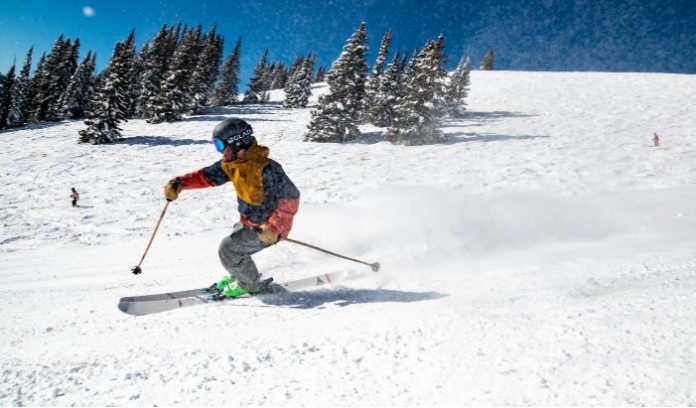Incorporating tricks and jumps into skiing, new school skiing evolved from snowboarding and freestyle skiing for the most part.
New school skiing is known as a form of freestyle skiing, but the tricks and jumps are more complex than mogul runs and aerials. New school skiing is usually done in terrain parks, such as those used by snowboarders.
New school skiing began in the late 1990s. It came about due to restrictive rules set by the International Ski Federation that affected freestyle skiers.
Freestyle skiers did not like the rules that were imposed on them by the federation, which limited tricks used in freestyle competitions.
Over the years, most ski resorts have catered to snowboarders and new school skiers by installing terrain parks that include rails, jumps, hips, quarter pipes, half pipes, and boxes.
For new school skiing, a twin-tip ski is recommended. These skis were made specifically for new schoolers. The twin-tip is turned up on both ends, allowing the new school skier to go either forward or backwards with ease.
But there are three different types of new school skis, which include Powder, All-Mountain, and Park. Of course, the type of new-school skiing you plan to do, and the terrain you plan to do it on will determine which type of ski that you need.
Backcountry skiing is popular among new scholars, but it is very dangerous. In fact, backcountry skiing has been banned in many parts of the world due to the danger, and also to preserve wildlife. Urban skiing, in new school terms, is often called jibbing.
It involves skiing off of anything that is handy such as stairs, stair rails, and even houses. You must also be aware that new school skiing could be considered vandalism in some urban areas.
New school skiers have a vocabulary of their own. If you want to get into this type of skiing, you need to know and understand the terminology.
The first word you will most likely hear is Jib or Jibbing. Jibs are rails, walls, or boxes. A Gap is a type of jump that has a large gap in the middle.
A Hip Jump is a jump that goes sideways, with the landing being on the side of the take off point. A spine is a jump is similar to a hip jump.
If the landing spot is higher than the take-off spot, this is called a step-up jump. Step down jumps, of course, have a landing that is lower than the takeoff point.
Tabletop jumps will have you taking off of a flat surface, clearing the air on a level with the takeoff point, and then landing on a downward slope.
While much of the terminology is the same as that used by snowboarders, there are differences. It is a whole new world of skiing that is challenging and fun.
Some consider new school skiing to be an extreme winter sport. There is of course rivalry between traditional skiers and new school skiers, but this only serves to make new school skiers a close-knit community.

